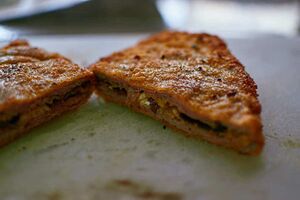Cachopo
Ask any Asturian what food defines the region, and most will say fabada. But if you ask them instead what is their favorite food, chances are they will say cachopo. And really, who can blame them? There are few meals quite as gluttonous as this.
If you are not familiar, veal cordon bleu, which cachopo is a version of, is two schnitzels turned into a stuffed sandwich. Imagine two chicken fried steaks, and in between – ham and cheese. It’s a step up (to me anyway) from the Chicken Cordon Bleu we love so much in America. So much so it has its own holiday.
In Asturias, veal is very popular. More so than most other beef, to be honest. It seems reasonable then that cordon bleu made with veal (as it is in Germany and Austria) would be more popular than that made with chicken (as it is in America and Japan). And so you find, in Spain, a very Austrian dish. Austrian, Asturian, the spelling is close enough anyway.
Cachopo History
Cachopo appears in Asturias somewhere between the 1940s and 1960s, depending on if you care more rumor or proof. For a more in depth story of the development of cachopo over time, read The History of Cachopo.
Ingredients
- 500 g veal. Ask the butcher to slice it for scalloppine.
- 100 g All purpose flour.
- 4 large eggs.
- 1 cup fine, white bread crumbs.
- 4 slices cecina, or equivalent dried meat product such as bresaola or thinly sliced country ham.
- 200 g goat cheese. I would use the most flavorful chevre you can find in your local grocery store for a reasonable price.
- Salt and pepper to taste.
Instructions
For the Schnitzel
- Pound the veal very thin using a meat mallet or wooden rolling pin. You may need to trim the scallops a little to make them match up, remove silverskin, or take off the odd dangling bit.
- Sprinkle both sides of the scallops with salt and pepper and leave to stand for 10 minutes or so while you arrange the next step
- Arrange your breading station:
- Put the flour on a plate or some wax paper.
- Crack the eggs into a pie plate and beat well.
- Put the breadcrumbs in a second pie plate.
- Line all three of these up on the counter so the breadcrumbs are closest to the stove and the flour the farthest away.
- Using a very large cast iron skillet, begin heating an inch or so of peanut oil (or other neutral frying oil) in the pan.
Filling and Frying
- Bread each slice:
- Dredge it in the flour.
- Then dredge it in the egg, allowing it to drip off a bit.
- Finally dredge it in the bread crumbs and set it on some paper.
- Repeat with all the slices.
- Assemble the filling:
- On half of the slices of veal, layout a layer of cecina.
- On the other half spread out a layer of the goat cheese.
- Lay one side on top of the other so that the cecina and goat cheese are both inside.
- Press the edges down well to seal the cachopo.
- Fry:
- Two to three minutes per side is plenty.
- Turn them over and fry the other side. (I find a large spatula in one hand and a pair of tongs in the other is the best way)
- Remove the fried cachopo to a wire rack or a towel lined plate and allow to stand for a few minutes before serving.
Notes
- It is traditional in Asturias to serve cachopo with french fries, roasted red peppers and/or fried Padron peppers.
- While the original cachopo in Asturias was served with a mushroom sauce, nowadays they are served without, in the style of schnitzels. At least through the 1960s the sauced version was popular, and during the 70s the sauce briefly moved inside the fillets, before disappearing entirely.
- Now, in addition to the standard ham and cheese filling (found throughout the rest of Spain as San Jacobo) a thousand types of cachopo are available across Asturias. The most well-adapted to local tastes, and the one I share below, is made with cecina and goat cheese. This is definitely my favorite way to make them.
